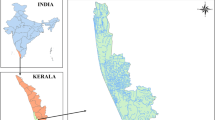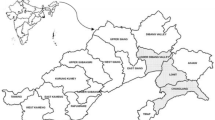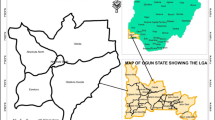Abstract
The fundamental changes in the land use and condition of the land in Gujrat (Punjab province, Pakistan), which have occurred over the past several decades, have been studied. They have a long history and represent an important factor in global changes in urban landscape. An attempt was made to determine the spatio-temporal changes in land use and land areas caused by anthropogenic activities. The study was carried out on the basis of multi-temporal satellite images (for 1985, 1995, 2005 and 2015) of the US Geological Survey, obtained from various Landsat satellites. Satellite image processing was carried out in the ERDAS Imagine 2014 and ArcGIS 10.3.1 programs. As a result, four maps were compiled that reflect the spatial and temporal dynamics of land. They are divided into five types: vegetation cover, bare soil, sand, water bodies and built-up areas. The results of the study indicate a significant decrease in the area of vegetation cover: from 85.1% in 1985 to 79.6% by 2015. There was also a significant increase in the built-up area, from 0.7 to 4.0% over a 30-year period. It has been established that unplanned changes in land use have an extremely negative impact on the ecological situation as well as on the human habitat. It has been concluded that it is necessary to conduct a reasonable policy aimed at correcting unplanned urbanization and the demographic situation in the province under consideration.




Similar content being viewed by others
REFERENCES
Frondoni, R., Mollo, B., and Capotorti, G., A landscape analysis of land cover change in the Municipality of Rome (Italy): Spatio-temporal characteristics and ecological implications of land cover transitions from 1954 to 2001, Landscape Urban Plann., 2011, vol. 100, nos. 1–2, pp. 117–128.
Ellis, E. and Pontius, R., Land-use and land-cover change, in Encyclopedia of Earth, Cleveland, C.J., Ed., Washington, DC: Environ. Inf. Coalition, Natl. Counc. Sci. Environ., 2006.
Guo, L., Wang, D., Qiu, J., Wang, L., and Liu, Y., Spatio-temporal patterns of land use change along the Bohai Rim in China during 1985–2005, J. Geogr. Sci., 2009, vol. 19, no. 5, p. 568.
Zhao, Y. and Wang, X., The spatial-temporal changes of land use/land cover in the upper reaches of Min River from 1986 to 2000, Proc. 4th Int. Conf. on Bioinformatics and Biomedical Engineering, Red Hook, NY: Curran Assoc., 2010, pp. 127–142.
Samiullah, Khan, M.A., Rahman, A.-U., and Mahmood, S., Evaluation of urban encroachment on farmland: a threat to urban agriculture in Peshawar City District, Pakistan, Erdkunde, 2019, vol. 73, no. 2, pp. 127–142.
Kucsicsa, G., Popovici, E.-A., Bălteanu, D., Grigorescu, I., Dumitraşcu, M., and Mitrică, B., Future land use/cover changes in Romania: regional simulations based on CLUE-S model and CORINE land cover database, Landscape Ecol. Eng., 2019, vol. 15, pp. 75–90.
Mishra, S., Shrivastava, P., and Dhurvey, P., Change detection techniques in remote sensing: a review, Int. J. Wireless Mob. Commun. Ind. Syst., 2017, vol. 4, no. 1, pp. 1–8.
Hassan, Z., Shabbir, R., Ahmad, S.S., Malik, A.H., Aziz, N., Butt, A., and Erum, S., Dynamics of land use and land cover change (LULCC) using geospatial techniques: a case study of Islamabad Pakistan, SpringerPlus, 2016, vol. 5, no. 1, p. 812.
Emenyonu, C., Orebiyi, J., Eze, C., Odii, M., Onyemauwa, C., and Eririogu, I., Analysis of land use cover change in Western Niger Delta: a panacea for agricultural land reduction, Niger. J. Agric. Econ., 2015, vol. 5, no. 1, p. 92.
Guzha, A., Rufino, M.C., Okoth, S., Jacobs, S., and Nóbrega, R., Impacts of land use and land cover change on surface runoff, discharge and low flows: evidence from East Africa, J. Hydrol.: Reg. Stud., 2018, vol. 15, pp. 49–67.
Yin, H., Pflugmacher, D., Li, A., Li, Z., and Hostert, P., Land use and land cover change in Inner Mongolia-understanding the effects of China’s re-vegetation programs, Remote Sens. Environ., 2018, vol. 204, pp. 918–930.
Planning, H.A.P., Gujrat Revision—Updation of outline Development Plan 1999–2024, Gujrat: Off. Deputy Dir. Reg. Phys. Plann. Rawalpindi, 1999.
Abid, M., Schilling, J., Scheffran, J., and Zulfiqar, F., Climate change vulnerability, adaptation and risk perceptions at farm level in Punjab, Pakistan, Sci. Total Environ., 2016, vol. 547, pp. 447–460.
Coppin, P., Jonckheere, I., Nackaerts, K., Muys, B., and Lambin, E., Review ArticleDigital change detection methods in ecosystem monitoring: a review, Int. J. Remote Sens., 2004, vol. 25, no. 9, pp. 1565–1596.
Cheruto, M.C., Kauti, M.K., Kisangau, P.D., and Kariuki, P.C., Assessment of land use and land cover change using GIS and remote sensing techniques: a case study of Makueni County, Kenya, J. Remote Sens. GIS, 2016, vol. 5, no. 4, pp. 1–6.
Kavzoglu, T. and Colkesen, I., A kernel functions analysis for support vector machines for land cover classification, Int. J. Appl. Earth Obs. Geoinf., 2009, vol. 11, no. 5, pp. 352–359.
Qian, J., Zhou, Q., and Hou, Q., Comparison of pixel-based and object-oriented classification methods for extracting built-up areas in arid zone, Proc. ISPRS Workshop on Up-Dating Geo-Spatial Databases with Imagery and the 5th ISPRS Workshop on DMGISs, Urumqi, China, Hannover: Int. Soc. Photogramm. Remote Sens. 2007, pp. 163–171.
Khalil, R.Z., In SAR coherence-based land cover classification of Okara, Pakistan, Egypt. J. Remote Sens. Space Sci., 2018, vol. 21, pp. S23–S28.
van de Voorde, T., De Genst, W., and Canters, F., Improving pixel-based VHR land-cover classifications of urban areas with post-classification techniques, Photogramm. Eng. Remote Sens., 2007, vol. 73, no. 9, p. 1017.
Owojori, A. and **e, H., Landsat image-based LULC changes of San Antonio, Texas using advanced atmospheric correction and object-oriented image analysis approaches, Proc. 5th Int. Symp. on Remote Sensing of Urban Areas, Tempe, AZ: Arizona State Univ., 2005, pp. 264–271.
Parece, T.E., Parece, T., Campbell, J., and McGee, J., Remote Sensing Analysis in an ArcMap Environment, Kindle Edition, 2015.
Lu, D. and Weng, Q., A survey of image classification methods and techniques for improving classification performance, Int. J. Remote Sens., 2007, vol. 28, no. 5, pp. 823–870.
Lea, C. and Curtis, A., Thematic Accuracy Assessment Procedures: National Park Service Vegetation Inventory, Version 2.0 (Natural Resource Report NPS/NRPC/ NRR-2010/204), Fort Collins, CO: National Park Service, 2010, pp. 2–19.
Nagarale, V.R. and Ohal, A.S., Changing urban land use in Pune Municipal Corporation, Pune, Maharashtra: 1981–2011, Maharashtra Bhugolshastra Parishad, 2017, vol. 34, no. 2, pp. 1–8.
Ghaffar, A., Use of geospatial techniques in monitoring urban expansion and land use change analysis: a case of Lahore, Pakistan, J. Basic Appl. Sci., 2015, vol. 11, pp. 265–273.
Iqbal, M.F. and Khan, I.A., Spatiotemporal land use land cover change analysis and erosion risk map** of Azad Jammu and Kashmir, Pakistan, Egypt. J. Remote Sens. Space Sci., 2014, vol. 17, no. 2, pp. 209–229.
Islam, M.S. and Ahmed, R., Land use change prediction in Dhaka city using GIS aided Markov chain modeling, J. Life Earth Sci., 2011, vol. 6, pp. 81–89.
Butt, A., Shabbir, R., Ahmad, S.S., and Aziz, N., Land use change map** and analysis using remote sensing and GIS: a case study of Simly watershed, Islamabad, Pakistan, Egypt. J. Remote Sens. Space Sci., 2015, vol. 18, no. 2, pp. 251–259.
Qasim, M., Hubacek, K., Termansen, M., and Khan, A., Spatial and temporal dynamics of land use pattern in District Swat, Hindu Kush Himalayan region of Pakistan, Appl. Geogr., 2011, vol. 31, no. 2, pp. 820–828.
Bonan, G.B., Forests and climate change: forcings, feedbacks, and the climate benefits of forests, Science, 2008, vol. 320, no. 5882, pp. 1444–1449.
Author information
Authors and Affiliations
Corresponding authors
Ethics declarations
The authors declare that they have no conflicts of interest.
Additional information
Translated by S. Avodkova
Rights and permissions
About this article
Cite this article
Mehdi, S.S., Miandad, M., Anwar, M.M. et al. Temporal Variation in Land Use and Land Cover in Gujrat (Pakistan) from 1985 to 2015. Geogr. Nat. Resour. 42, 386–394 (2021). https://doi.org/10.1134/S1875372821040107
Received:
Revised:
Accepted:
Published:
Issue Date:
DOI: https://doi.org/10.1134/S1875372821040107




